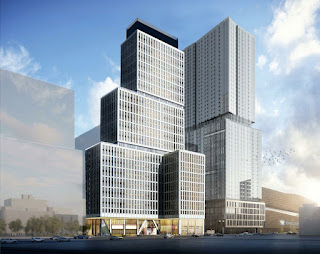If B5 rises, developers seek 30% (middle-income) affordability, under expired 421-a benefit. Tax break deadline: 2026. But affordable housing deadline: 2025.
As I wrote this week, documents confirmed that developers of the B12/B13 towers--TF Cornerstone, after leasing the sites from master developer Greenland Forest City Partners--plan 30% affordable units at 130% of Area Median Income (AMI), or middle-income households likely earning six figures.
TF Cornerstone, not surprisingly, had refused to acknowledge that publicly, since such "affordable" housing--better termed "income-targeted"--hardly serves those who marched for the project.
It's hardly surprising the developers would seek to maximize their economic return: that configuration is the most lucrative under the various options presented by the now-expired 421-a tax break, which required buildings to start by 6/15/22--even with just one foundation--and be completed by 6/15/26.
700 Atlantic, as well
Similarly, and unsurprisingly, a document shows that the long-gestating B5--700 Atlantic Avenue, the first tower built over the Vanderbilt Yard--is also planned to have 30% affordable housing, surely with units aimed at the same middle-income cohort, at 130% of AMI.
The Q3 2022 Downtown Brooklyn Development Matrix, produced by the Downtown Brooklyn Partnership, includes 700 Atlantic among future "pipeline projects," expected but not launched, and states that the 682-unit would include 478 market rentals and 204 affordable ones. That's 30%.
 |
| B5, center-left, plus (built) B4. Dattner Architects |
(The B5 image at right appeared in a Department of Buildings, or DOB, filing.)
The platform was expected to start in June, Greenland USA's Scott Solish said in May, pending LIRR and Department of Buildings (DOB) approvals, and the first phase should take three years,which meant completion by mid-2025.
That didn't happen, which raises questions about Greenland's commitment to the project and/or finances--or perhaps unresolved permitting issues.
 |
| Rebar indicates previous work on footings |
"So you won't know if you're qualified maybe for two or three years," Veconi continued.
"Yeah, we anticipate that we have," Solish said, but it's not up to the developer but requires approval by HPD, the city's Department of Housing Preservation and Development.
Solish said yes, that there is "some pre-certification work that can happen," but acknowledged the issue was for experts.

Comments
Post a Comment